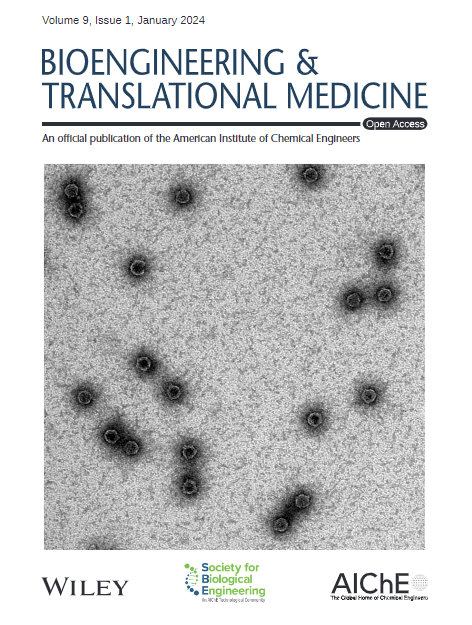Engineering biomimetic nanovesicles for PEBP1 mRNA delivery to inhibit ferroptosis in abdominal aortic aneurysm
IF 6.1
2区 医学
Q1 ENGINEERING, BIOMEDICAL
引用次数: 0
Abstract
An abdominal aortic aneurysm (AAA) is a life‐threatening vascular condition characterized by the dilation of the abdominal aorta, with ferroptosis playing a significant role in its pathogenesis. This study investigates the therapeutic potential of engineering biomimetic nanovesicles to deliver phosphatidylethanolamine‐binding protein 1 (PEBP1) mRNA for inhibiting ferroptosis in vascular smooth muscle cells (VSMCs) and preventing AAA progression. Differential gene expression analysis of the AAA transcriptomic dataset GSE57691 identified 243 differentially expressed genes (DEGs), intersecting with 12 ferroptosis‐related genes. Single‐cell analysis of dataset GSE237230 highlighted PEBP1 as a key gene in VSMCs. Overexpression of PEBP1 in VSMCs enhanced proliferation, reduced reactive oxygen species (ROS) and iron levels, and inhibited apoptosis and ferroptosis via the NRF2/GPX4 axis. The engineered biomimetic nanovesicles demonstrated significant uptake by VSMCs and effective delivery of PEBP1 mRNA. In vivo studies confirmed that these nanovesicles substantially inhibited AAA progression in mice. This study presents a novel bioengineering approach for AAA treatment by targeting ferroptosis through PEBP1 mRNA delivery, offering a promising molecular strategy for the prevention and management of AAA.工程仿生纳米囊递送PEBP1 mRNA抑制腹主动脉瘤铁下垂
腹主动脉瘤(AAA)是一种以腹主动脉扩张为特征的危及生命的血管疾病,铁下垂在其发病机制中起重要作用。本研究探讨了工程仿生纳米囊泡递送磷脂酰乙醇胺结合蛋白1 (PEBP1) mRNA抑制血管平滑肌细胞(VSMCs)铁上吊并阻止AAA进展的治疗潜力。AAA转录组数据集GSE57691的差异基因表达分析鉴定出243个差异表达基因(DEGs),与12个铁下垂相关基因相交。数据集GSE237230的单细胞分析显示PEBP1是VSMCs的关键基因。PEBP1在VSMCs中的过表达通过NRF2/GPX4轴增强增殖,降低活性氧(ROS)和铁水平,抑制细胞凋亡和铁凋亡。经过改造的仿生纳米囊泡被VSMCs显著吸收,并能有效递送PEBP1 mRNA。体内研究证实,这些纳米囊泡实质上抑制了小鼠AAA的进展。本研究提出了一种新的生物工程方法,通过PEBP1 mRNA传递靶向铁下垂治疗AAA,为AAA的预防和管理提供了一种有前途的分子策略。
本文章由计算机程序翻译,如有差异,请以英文原文为准。
求助全文
约1分钟内获得全文
求助全文
来源期刊

Bioengineering & Translational Medicine
Pharmacology, Toxicology and Pharmaceutics-Pharmaceutical Science
CiteScore
8.40
自引率
4.10%
发文量
150
审稿时长
12 weeks
期刊介绍:
Bioengineering & Translational Medicine, an official, peer-reviewed online open-access journal of the American Institute of Chemical Engineers (AIChE) and the Society for Biological Engineering (SBE), focuses on how chemical and biological engineering approaches drive innovative technologies and solutions that impact clinical practice and commercial healthcare products.
 求助内容:
求助内容: 应助结果提醒方式:
应助结果提醒方式:


